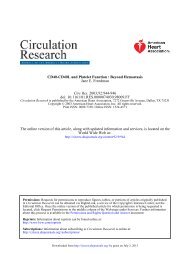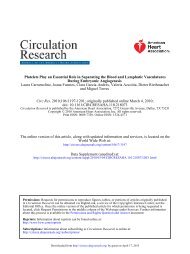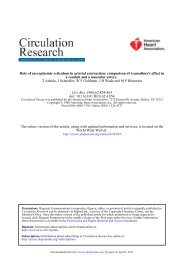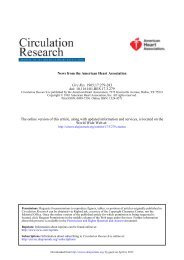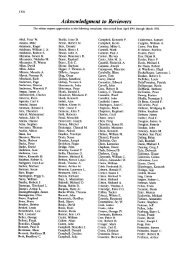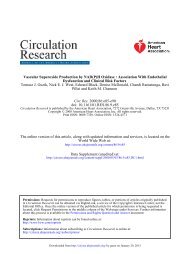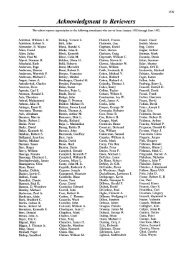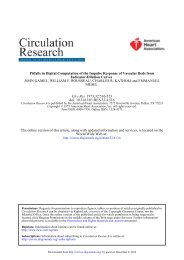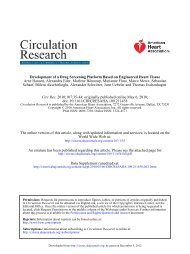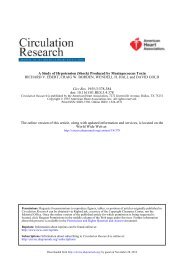Tetralogy of Fallot and Alterations in Vascular Endothelial Growth ...
Tetralogy of Fallot and Alterations in Vascular Endothelial Growth ...
Tetralogy of Fallot and Alterations in Vascular Endothelial Growth ...
Create successful ePaper yourself
Turn your PDF publications into a flip-book with our unique Google optimized e-Paper software.
<strong>Tetralogy</strong> <strong>of</strong> <strong>Fallot</strong> <strong>and</strong> <strong>Alterations</strong> <strong>in</strong> <strong>Vascular</strong> <strong>Endothelial</strong> <strong>Growth</strong> Factor-A Signal<strong>in</strong>g<br />
<strong>and</strong> Notch Signal<strong>in</strong>g <strong>in</strong> Mouse Embryos Solely Express<strong>in</strong>g the VEGF120 Is<strong>of</strong>orm<br />
Nynke M. S. van den Akker, Daniël G. M. Mol<strong>in</strong>, Patricia P. W. M. Peters, Saskia Maas,<br />
Lambertus J. Wisse, Ronald van Brempt, Conny J. van Munsteren, Margot M. Bartel<strong>in</strong>gs,<br />
Robert E. Poelmann, Peter Carmeliet <strong>and</strong> Adriana C. Gittenberger-de Groot<br />
Circ Res. published onl<strong>in</strong>e March 1, 2007;<br />
Circulation Research is published by the American Heart Association, 7272 Greenville Avenue, Dallas, TX 75231<br />
Copyright © 2007 American Heart Association, Inc. All rights reserved.<br />
Pr<strong>in</strong>t ISSN: 0009-7330. Onl<strong>in</strong>e ISSN: 1524-4571<br />
The onl<strong>in</strong>e version <strong>of</strong> this article, along with updated <strong>in</strong>formation <strong>and</strong> services, is located on the<br />
World Wide Web at:<br />
http://circres.ahajournals.org/content/early/2007/03/01/01.RES.0000261656.04773.39.citation<br />
Data Supplement (unedited) at:<br />
http://circres.ahajournals.org/content/suppl/2007/03/02/01.RES.0000261656.04773.39.DC1.html<br />
Permissions: Requests for permissions to reproduce figures, tables, or portions <strong>of</strong> articles orig<strong>in</strong>ally published<br />
<strong>in</strong> Circulation Research can be obta<strong>in</strong>ed via RightsL<strong>in</strong>k, a service <strong>of</strong> the Copyright Clearance Center, not the<br />
Editorial Office. Once the onl<strong>in</strong>e version <strong>of</strong> the published article for which permission is be<strong>in</strong>g requested is<br />
located, click Request Permissions <strong>in</strong> the middle column <strong>of</strong> the Web page under Services. Further <strong>in</strong>formation<br />
about this process is available <strong>in</strong> the Permissions <strong>and</strong> Rights Question <strong>and</strong> Answer document.<br />
Repr<strong>in</strong>ts: Information about repr<strong>in</strong>ts can be found onl<strong>in</strong>e at:<br />
http://www.lww.com/repr<strong>in</strong>ts<br />
Subscriptions: Information about subscrib<strong>in</strong>g to Circulation Research is onl<strong>in</strong>e at:<br />
http://circres.ahajournals.org//subscriptions/<br />
Downloaded from<br />
http://circres.ahajournals.org/ by guest on February 7, 2013
<strong>Tetralogy</strong> <strong>of</strong> <strong>Fallot</strong> <strong>and</strong> <strong>Alterations</strong> <strong>in</strong> <strong>Vascular</strong> <strong>Endothelial</strong><br />
<strong>Growth</strong> Factor-A Signal<strong>in</strong>g <strong>and</strong> Notch Signal<strong>in</strong>g <strong>in</strong> Mouse<br />
Embryos Solely Express<strong>in</strong>g the VEGF120 Is<strong>of</strong>orm<br />
Nynke M. S. van den Akker, Daniël G. M. Mol<strong>in</strong>, Patricia P. W. M. Peters, Saskia Maas,<br />
Lambertus J. Wisse, Ronald van Brempt, Conny J. van Munsteren, Margot M. Bartel<strong>in</strong>gs,<br />
Robert E. Poelmann, Peter Carmeliet, Adriana C. Gittenberger-de Groot<br />
Abstract—The importance <strong>of</strong> vascular endothelial growth factor-A (VEGF) <strong>and</strong> subsequent Notch signal<strong>in</strong>g <strong>in</strong> cardiac<br />
outflow tract development is generally recognized. Although genetic heterogeneity <strong>and</strong> mutations <strong>of</strong> these genes<br />
<strong>in</strong> both humans <strong>and</strong> mouse models relate to a high susceptibility to develop outflow tract malformations such as<br />
tetralogy <strong>of</strong> <strong>Fallot</strong> <strong>and</strong> peripheral pulmonary stenosis, no etiology has been proposed so far. Us<strong>in</strong>g immunohistochemistry,<br />
<strong>in</strong> situ hybridization, <strong>and</strong> quantitative RT-PCR on embryonic hearts, we have shown spatiotemporal<br />
<strong>in</strong>crease <strong>and</strong> abnormal pattern<strong>in</strong>g <strong>of</strong> Vegf/VEGF/(phosphorylated) VEGFR-2, (cleaved) Notch1, <strong>and</strong> Jagged2 <strong>in</strong> the<br />
outflow tract <strong>of</strong> Vegf120/120 mouse embryos. This co<strong>in</strong>cides with hyperplasia <strong>of</strong> specifically the outflow tract<br />
cushions <strong>and</strong> a high degree <strong>of</strong> subpulmonary myocardial apoptosis that, <strong>in</strong> later stages, manifest as pulmonary<br />
stenosis <strong>and</strong> ventricular septal defects. We postulate that <strong>in</strong>crease <strong>of</strong> VEGF <strong>and</strong> Notch signal<strong>in</strong>g dur<strong>in</strong>g right<br />
ventricular outflow tract development can lead to abnormal development <strong>of</strong> both cushion <strong>and</strong> myocardial<br />
structures. Defective right ventricular outflow tract development as presented provides new <strong>in</strong>sight <strong>in</strong> the etiology<br />
<strong>of</strong> <strong>Tetralogy</strong> <strong>of</strong> <strong>Fallot</strong>. (Circ Res. 2007;100:0-0.)<br />
The importance <strong>of</strong> vascular endothelial growth factor-A<br />
(VEGF) for angiogenesis is ultimately demonstrated by<br />
the early embryonic death <strong>of</strong> both VEGF heterozygous <strong>and</strong><br />
VEGF receptor (VEGFR)-2 homozygous knockout mice. 1,2<br />
Recent data po<strong>in</strong>t toward a critical role for VEGF dur<strong>in</strong>g<br />
cardiac development as well. It has been shown <strong>in</strong> humans<br />
that a low expression VEGF haplotype correlates with <strong>in</strong>creased<br />
risk for tetralogy <strong>of</strong> <strong>Fallot</strong> (TOF), a congenital heart<br />
disease consist<strong>in</strong>g <strong>of</strong> a ventricular septal defect (VSD),<br />
pulmonary stenosis, <strong>and</strong> dextroposition <strong>of</strong> the aorta. 3,4 Furthermore,<br />
the VEGF165 is<strong>of</strong>orm has been postulated as a<br />
modifier <strong>of</strong> the cardiovascular phenotype <strong>in</strong> the human<br />
DiGeorge syndrome. 5 In addition, mouse models <strong>in</strong> which<br />
genes <strong>of</strong> prote<strong>in</strong>s <strong>in</strong>volved <strong>in</strong> VEGF signal<strong>in</strong>g are mutated<br />
show comparable cardiac malformations. 6–9<br />
Dur<strong>in</strong>g cardiac development, the early outflow tract (OFT)<br />
must be divided <strong>in</strong>to the aortic <strong>and</strong> pulmonary OFT with<br />
proper alignment to the left <strong>and</strong> right ventricle, respectively.<br />
Here, the development <strong>of</strong> both the endocardial cushions <strong>and</strong><br />
the adjacent myocardium is crucial. With<strong>in</strong> this process, the<br />
cushions must be populated by cells predom<strong>in</strong>antly recruited<br />
Key Words: tetralogy <strong>of</strong> <strong>Fallot</strong> � apoptosis � VEGF � Notch<br />
from the cushion endocardium through epithelial–mesenchymal<br />
transformation (EMT). A role for VEGF <strong>in</strong> atrioventricular<br />
cushion EMT has been shown, albeit both stimulat<strong>in</strong>g<br />
10,11 <strong>and</strong> <strong>in</strong>hibit<strong>in</strong>g. 12 This led to the hypothesis that VEGF<br />
must be expressed with<strong>in</strong> a “physiological w<strong>in</strong>dow” dur<strong>in</strong>g<br />
cushion development. 13<br />
The myocardium <strong>of</strong> the pulmonary OFT, derived from the<br />
secondary heart field (SHF), is a dist<strong>in</strong>ct population added to<br />
the arterial pole after the <strong>in</strong>itial heart tube is formed. 14 SHF<br />
addition is critical for OFT development as ablation <strong>of</strong> the<br />
SHF <strong>in</strong> chicken embryos leads to cardiac malformations such<br />
as TOF, <strong>in</strong> which anomalous OFT development is obvious.<br />
15,16 Furthermore, upregulated by hypoxia, VEGF seems<br />
to play a role <strong>in</strong> this part <strong>of</strong> OFT development. 17<br />
VEGF signal<strong>in</strong>g can upregulate members <strong>of</strong> the Jagged/<br />
Delta-like/Notch family. 18,19 JAGGED1 mutations <strong>in</strong> humans<br />
are correlated with TOF or pulmonary stenosis. 20–22 Involvement<br />
<strong>of</strong> other members <strong>of</strong> Notch signal<strong>in</strong>g <strong>in</strong> cardiac development<br />
has been demonstrated by several mouse mutants. 23–25<br />
Notch has also been described to stimulate endocardial cushion<br />
Orig<strong>in</strong>al received September 14, 2006; revision received February 12, 2007; accepted February 19, 2007.<br />
From the Departments <strong>of</strong> Anatomy <strong>and</strong> Embryology (N.M.S.v.d.A., D.G.M.M., S.M., L.J.W., C.J.v.M., M.M.B., R.E.P., A.C.G.-d.G.) <strong>and</strong> Pediatric<br />
Intensive Care (R.v.B.), Leiden University Medical Center, The Netherl<strong>and</strong>s; the Department <strong>of</strong> Physiology (D.G.M.M., P.P.W.M.P.), Cardiovascular<br />
Research Institute Maastricht, Maastricht University, The Netherl<strong>and</strong>s; <strong>and</strong> the Center for Transgene Technology & Gene Therapy (P.C.), University <strong>of</strong><br />
Leuven, Belgium.<br />
Correspondence to Adriana C. Gittenberger-de Groot, PhD, Department <strong>of</strong> Anatomy <strong>and</strong> Embryology, Leiden University Medical Center,<br />
E<strong>in</strong>thovenweg 20, PO Box 9600, 2300 RC Leiden, The Netherl<strong>and</strong>s. E-mail acgitten@lumc.nl<br />
© 2007 American Heart Association, Inc.<br />
Circulation Research is available at http://circres.ahajournals.org DOI: 10.1161/01.RES.0000261656.04773.39<br />
Downloaded from<br />
http://circres.ahajournals.org/ 1 by guest on February 7, 2013
2 Circulation Research March 30, 2007<br />
EMT, 23,26 imply<strong>in</strong>g a potential effect <strong>of</strong> VEGF on cushion<br />
development via Notch signal<strong>in</strong>g.<br />
To <strong>in</strong>vestigate the role <strong>of</strong> VEGF <strong>and</strong> Notch signal<strong>in</strong>g, we<br />
made use <strong>of</strong> the previously described Vegf120/120 mouse<br />
model. 5,27 We demonstrate that Vegf120/120 mouse embryos,<br />
which solely express the VEGF120 is<strong>of</strong>orm, are highly<br />
susceptible for development <strong>of</strong> TOF. We hypothesize that this<br />
is most likely attributable to spatiotemporal elevations <strong>of</strong><br />
VEGF <strong>and</strong> Notch signal<strong>in</strong>g, ma<strong>in</strong>ly seen <strong>in</strong> the SHF-derived<br />
right ventricular OFT myocardium.<br />
Materials <strong>and</strong> Methods<br />
Mouse Embryos <strong>and</strong> Tissue Process<strong>in</strong>g<br />
All animal experiments were approved by the Animal Ethics<br />
Committee <strong>of</strong> the Leiden University <strong>and</strong> performed accord<strong>in</strong>g to<br />
the Guide for the Care <strong>and</strong> Use <strong>of</strong> Laboratory Animals published<br />
by the NIH. An extensive description <strong>of</strong> mouse experiments<br />
can be found <strong>in</strong> the onl<strong>in</strong>e data supplement, available at<br />
http://circres.ahajournals.org.<br />
Immunohistochemistry<br />
Paraff<strong>in</strong> sections <strong>of</strong> 5 �mol/L were <strong>in</strong>cubated overnight with primary<br />
antibody; after which, sections were <strong>in</strong>cubated with secondary<br />
antibody. For the detection <strong>of</strong> apoptosis, the TUNEL kit was used<br />
(1684817, Roche/Boehr<strong>in</strong>ger Mannheim, Basel, Switzerl<strong>and</strong>). An<br />
extensive description <strong>of</strong> the technique <strong>and</strong> <strong>of</strong> the antibodies used can<br />
be found <strong>in</strong> the onl<strong>in</strong>e data supplement.<br />
In Situ Hybridization<br />
Sense <strong>and</strong> antisense 35 S-radiolabeled Vegf-A RNA probes were<br />
transcribed us<strong>in</strong>g a 451-bp clone encod<strong>in</strong>g for the mouse Vegf-120<br />
is<strong>of</strong>orm (pVEGF2; k<strong>in</strong>dly provided by Dr G. Breier, University <strong>of</strong><br />
Technology, Dresden, Germany). Radioactive <strong>in</strong> situ hybridization<br />
was performed. 28 A brief description can be found <strong>in</strong> the onl<strong>in</strong>e data<br />
supplement.<br />
Quantitative RT-PCR<br />
RNA was isolated us<strong>in</strong>g the RNeasy m<strong>in</strong>i kit (Qiagen). All samples<br />
were normalized for <strong>in</strong>put based on �-act<strong>in</strong> <strong>and</strong> GAPDH. Data<br />
analyses were performed us<strong>in</strong>g an Excel spreadsheet based on<br />
geNorm (Relative expression with error propagation). 29 Statistic<br />
significance was tested us<strong>in</strong>g r<strong>and</strong>omization test<strong>in</strong>g, as provided <strong>in</strong><br />
the REST2005 program. 30 Samples with a probability value <strong>of</strong><br />
�0.05 were regarded to be significant different between the groups.<br />
Primer sequences <strong>and</strong> detailed description <strong>of</strong> the technique appear <strong>in</strong><br />
the onl<strong>in</strong>e data supplement (supplemental Table II).<br />
Three-Dimensional Reconstruction<br />
Three-dimensional reconstructions were performed as described. 31<br />
In short, micrographs were made <strong>of</strong> every seventh section <strong>of</strong><br />
embryonic day 12.5 (E12.5) <strong>and</strong> E19.5 hearts <strong>of</strong> wild-type embryos<br />
<strong>and</strong> Vegf120/120 littermates. The micrographs were converted to 3D<br />
us<strong>in</strong>g AMIRA s<strong>of</strong>tware (Template Graphics S<strong>of</strong>tware Inc, San<br />
Diego, Calif).<br />
Results<br />
Morphology<br />
Right Ventricular OFT Development Is Impaired<br />
At E10.5, the development <strong>of</strong> the common OFT <strong>of</strong> Vegf120/<br />
120 embryos was comparable to wild-type littermates. In<br />
E11.5 to E13.5 mutants, we could observe hyperplasia <strong>of</strong> the<br />
proximal OFT cushions (Figure 1a <strong>and</strong> 1e; Table 1). More<br />
strik<strong>in</strong>g, <strong>in</strong> all <strong>of</strong> these embryos, a large apoptotic r<strong>in</strong>g<br />
surrounded the right ventricular OFT, as observed us<strong>in</strong>g<br />
Mayer’s hematoxyl<strong>in</strong> (Table 1), 32 as well as with TUNEL<br />
sta<strong>in</strong><strong>in</strong>g, specifically located <strong>in</strong> the subpulmonary myocardium<br />
up to the level <strong>of</strong> the develop<strong>in</strong>g pulmonary valves<br />
(Figure 1b through 1d <strong>and</strong> 1f through 1h). Stenosis <strong>of</strong> the<br />
right ventricular OFT concomitant with hypoplasia <strong>of</strong> the<br />
pulmonary trunk or pulmonary arteries was apparent <strong>in</strong><br />
several cases (Figure 1c <strong>and</strong> 1g; Table 1).<br />
At E14.5 to E19.5, right ventricular OFT abnormalities<br />
varied from stenosis <strong>of</strong> the left pulmonary artery at the level<br />
<strong>of</strong> branch<strong>in</strong>g from the pulmonary trunk (Figure 1i <strong>and</strong> 1m) to<br />
stenosis <strong>of</strong> the right ventricular OFT, which was always<br />
accompanied by hypoplasia <strong>of</strong> the pulmonary trunk (Table 2).<br />
In cases with severe OFT stenosis, almost complete atresia <strong>of</strong><br />
the pulmonary trunk was seen (Figure 1j <strong>and</strong> 1n).<br />
Pulmonary OFT <strong>and</strong> Aortic Arch Defects<br />
All pharyngeal arch arteries were present <strong>in</strong> Vegf120/120<br />
embryos <strong>of</strong> E10.5, exclud<strong>in</strong>g anomalous anlage. Already at<br />
E11.5, associated with pulmonary OFT stenosis, atresia <strong>of</strong> the<br />
ductus arteriosus (DA) was observed <strong>in</strong> 2 <strong>of</strong> 4 embryos. From<br />
E14.5 onward, an atretic str<strong>and</strong> or absence <strong>of</strong> the DA was<br />
seen (Figure 1k <strong>and</strong> 1o) <strong>and</strong> co<strong>in</strong>cided <strong>in</strong> 8 <strong>of</strong> 9 cases with<br />
pulmonary OFT stenosis (Table 2). Other aortic arch malformations<br />
observed from E14.5 onward were right or double<br />
aortic arch with right dom<strong>in</strong>ance <strong>and</strong> a right DA (Figure 1lp;<br />
Table 2) or hypoplasia <strong>of</strong> the aortic arch (5/31). Pulmonary/<br />
systemic collateral arteries from the dorsal aorta to the lungs<br />
were found <strong>in</strong> embryos with pulmonary stenosis <strong>and</strong> absence<br />
<strong>of</strong> the DA at later stages <strong>of</strong> development (data not shown).<br />
Other Cardiac Anomalies<br />
Correct loop<strong>in</strong>g <strong>of</strong> the early heart tube is crucial for proper<br />
cardiac septation. In half <strong>of</strong> the E10.5 to E11.5 Vegf120/120<br />
embryos, loop<strong>in</strong>g was dim<strong>in</strong>ished (Figure 2a <strong>and</strong> 2d), lead<strong>in</strong>g<br />
to a wider <strong>in</strong>ner curvature <strong>and</strong> a ventral displacement <strong>of</strong> the<br />
OFT. Vegf120/120 embryos <strong>of</strong> E11.5 to E13.5 showed<br />
malposition <strong>of</strong> the OFT cushions, together with ventral<br />
displacement <strong>of</strong> the OFT (Table 1), which, at later stages<br />
(E14.5 to E19.5), was concomitant with subaortic VSDs<br />
(Figure 2b <strong>and</strong> 2e; Table 2). Significant dextroposition <strong>of</strong> the<br />
aorta <strong>and</strong> a subaortic VSD, which is referred to as a<br />
double-outlet right ventricle (Table 2), went along with a<br />
side-by-side position<strong>in</strong>g <strong>of</strong> the great arteries (Figure 2c <strong>and</strong><br />
2f). Often, a comb<strong>in</strong>ation <strong>of</strong> a subaortic VSD, dextroposition<br />
<strong>of</strong> the aorta <strong>and</strong> right ventricular OFT stenosis, TOF, was<br />
found (Table 2).<br />
Signal<strong>in</strong>g<br />
Vegf120 mRNA Levels Are Increased <strong>and</strong> Pattern<strong>in</strong>g<br />
Is Abnormal<br />
To determ<strong>in</strong>e the mRNA levels <strong>of</strong> the different Vegf is<strong>of</strong>orms<br />
dur<strong>in</strong>g normal cardiac development, is<strong>of</strong>orm-specific quantitative<br />
PCR on normal hearts <strong>of</strong> E14.5, E16.5, <strong>and</strong> E18.5 was<br />
performed. In this time span, Vegf120 was least prom<strong>in</strong>ent<br />
compared with the larger is<strong>of</strong>orms, although a temporal<br />
<strong>in</strong>crease was seen at E16.5 (Figure 3a). When compar<strong>in</strong>g total<br />
Vegf mRNA levels <strong>of</strong> wild-type to Vegf120/120 hearts, no<br />
significant difference was found (Figure 3b). However, when<br />
only the expression <strong>of</strong> the Vegf120 is<strong>of</strong>orm was compared, a<br />
Downloaded from<br />
http://circres.ahajournals.org/ by guest on February 7, 2013
Figure 1. OFT <strong>and</strong> aortic arch malformations <strong>in</strong> Vegf120/120 mouse embryos. The sta<strong>in</strong><strong>in</strong>gs performed are <strong>in</strong>dicated <strong>in</strong> the upper right<br />
corner <strong>of</strong> each panel. Wild-type (�/�) <strong>and</strong> Vegf120/120 (120) mice are compared, as <strong>in</strong>dicated <strong>in</strong> the top left corner, together with the<br />
age <strong>in</strong> embryonic days. Dur<strong>in</strong>g OFT development, an <strong>in</strong>creased volume <strong>of</strong> the mesenchyme <strong>of</strong> the OFT cushions (OC) is observed (a<br />
<strong>and</strong> e). Apoptosis <strong>of</strong> the subpulmonary myocardium is seen (b, dotted areas f). c, d, g, <strong>and</strong> h, Three-dimensional reconstructions <strong>of</strong><br />
anti–�/� muscle act<strong>in</strong> (�/�MA)-sta<strong>in</strong>ed sections. The p<strong>in</strong>k structure is the ascend<strong>in</strong>g aorta (A), <strong>and</strong> the green structure the pulmonary<br />
trunk (P), which is stenotic <strong>in</strong> the Vegf120/120 embryo. The purple area <strong>in</strong>dicated with the arrow is apoptotic subpulmonary myocardium.<br />
Severe stenosis <strong>of</strong> the left pulmonary artery (LPA) was seen (l<strong>in</strong>es <strong>in</strong> i <strong>and</strong> m) or even almost complete obliteration <strong>of</strong> the pulmonary<br />
trunk (l<strong>in</strong>es <strong>in</strong> j <strong>and</strong> n). Both atresia <strong>of</strong> the DA (k <strong>and</strong> o) <strong>and</strong> a right DA (l vs p), co<strong>in</strong>cid<strong>in</strong>g with a right aortic arch, could be<br />
observed. �-SMA <strong>in</strong>dicates �-smooth muscle act<strong>in</strong>; DAO, dorsal aorta; LV, left ventricle; O, esophagus; RV, right ventricle; TUNEL, term<strong>in</strong>al<br />
deoxynucleotidyl transferase biot<strong>in</strong> dUTP nick-end label<strong>in</strong>g. Scale bar: 60 �mol/L (a, b, e, f, k, <strong>and</strong> o); 200 �mol/L (i, j, l, m, n,<br />
<strong>and</strong> p).<br />
6- to 16-fold <strong>in</strong>crease was seen <strong>in</strong> the Vegf120/120 hearts,<br />
be<strong>in</strong>g most prom<strong>in</strong>ent at E16.5 (Figure 3c).<br />
Spatiotemporal changes <strong>in</strong> Vegf mRNA pattern<strong>in</strong>g were<br />
<strong>in</strong>vestigated <strong>in</strong> Vegf120/120 embryonic hearts, us<strong>in</strong>g radioactive<br />
<strong>in</strong> situ hybridization. Between E10.5 to E14.5, high<br />
expression was observed <strong>in</strong> the OFT myocardium at the level<br />
<strong>of</strong> the OFT cushions, whereas very low expression was seen<br />
<strong>in</strong> the endocardium <strong>of</strong> the OFT cushions <strong>of</strong> wild-type embryos<br />
(Figure 4a, 4b, 4d, <strong>and</strong> 4e). Increased Vegf mRNA<br />
signal <strong>in</strong> the endocardial cells <strong>of</strong> the OFT cushions was found<br />
<strong>in</strong> Vegf120/120 embryos <strong>of</strong> E10.5, whereas the level <strong>in</strong> the<br />
TABLE 1. Outflow Abnormalities <strong>in</strong> Vegf120/120 Embryos<br />
Cardiac Anomaly No./Total Percentage<br />
Apoptosis subpulmonary myocardium 14/14 100<br />
Hyperplasia OFT cushions 8/14 57<br />
Only 3/14 21<br />
Plus malposition OFT cushions 5/14 36<br />
Hypoplasia PT/PA 9/14 64<br />
Only 3/14 21<br />
Plus stenosis RV-OFT* 6/14 43<br />
Plus hyperplasia OFT cushions 2/14 14<br />
Age <strong>of</strong> embryos was E11.5 to E13.5. PT/PA <strong>in</strong>dicates pulmonary trunk/pulmonary<br />
artery(ies); RV-OFT, right ventricular OFT. *These 6/14 embryos<br />
represent all aged E11.5 to E13.5 with stenosis <strong>of</strong> the right ventricular OFT.<br />
Van den Akker et al VEGF <strong>and</strong> Notch <strong>in</strong> TOF Development 3<br />
OFT myocardium was comparable between genotypes at this<br />
age (Figure 4d). In Vegf120/120 embryos <strong>of</strong> E14.5, a highly<br />
<strong>in</strong>creased Vegf signal was seen <strong>in</strong> the subpulmonary myocardium<br />
(Figure 4e), up to the level <strong>of</strong> the OFT valves when<br />
compared with wild-type littermates (Figure 4b). In wild-type<br />
embryos <strong>of</strong> E16.5, the highest expression was present at the<br />
borderl<strong>in</strong>e <strong>of</strong> compact to trabecular myocardium (data not<br />
shown). At E18.5, only scattered Vegf expression was observed<br />
(Figure 4c). In Vegf120/120 hearts <strong>of</strong> E16.5 to E18.5,<br />
the OFT myocardial signal was higher (data not shown) <strong>and</strong><br />
the expression at the borderl<strong>in</strong>e <strong>of</strong> compact to trabecular<br />
myocardium was markedly <strong>in</strong>creased (Figure 4f).<br />
Increased Expression <strong>of</strong> VEGF, (Phosphorylated)<br />
VEGFR-2, (Cleaved) Notch1, <strong>and</strong> Jagged2 <strong>in</strong> the OFT<br />
In accordance with the <strong>in</strong> situ hybridization data, VEGF<br />
levels were <strong>in</strong>creased <strong>in</strong> the endothelium <strong>of</strong> the OFT cushions<br />
at E10.5 (Figure 5a <strong>and</strong> 5e). In older embryos (E13.5 <strong>and</strong><br />
older), the VEGF prote<strong>in</strong> expression was equally distributed<br />
throughout wild-type myocardium, whereas the sta<strong>in</strong><strong>in</strong>g <strong>in</strong>tensity<br />
was higher <strong>in</strong> the trabeculae compared with the<br />
compact myocardium <strong>in</strong> Vegf120/120 embryos (data not<br />
shown). In wild-type embryos <strong>of</strong> E10.5, VEGFR-2 expression<br />
was present throughout the myocardium <strong>and</strong> <strong>in</strong> the<br />
endocardium <strong>of</strong> the OFT. Expression <strong>in</strong> these cell types was<br />
higher <strong>in</strong> the Vegf120/120 embryos (Figure 5b <strong>and</strong> 5f).<br />
Although <strong>in</strong> wild types <strong>of</strong> E18.5 <strong>and</strong> older the myocardial<br />
Downloaded from<br />
http://circres.ahajournals.org/ by guest on February 7, 2013
4 Circulation Research March 30, 2007<br />
TABLE 2. TOF-Related Abnormalities <strong>in</strong> Vegf120/120 Embryos<br />
Cardiac Anomaly No./Total Percentage<br />
VSD 13/31 42<br />
Subaortic 11/31 35<br />
Plus muscular 2/31 6<br />
Muscular only 2/31 6<br />
Subaortic VSD�dextroposition aorta (DORV) 10/31 32<br />
Plus stenosis RV-OFT (TOF) 9/31 29<br />
Hypoplasia PT/PA 19/31 61<br />
Only 9/31 29<br />
Plus stenosis RV-OFT* 10/31 32<br />
Plus atresia DA† 8/31 26<br />
Right aortic arch 4/31 13<br />
Only 3/31 10<br />
Plus TOF 1/31 3<br />
Double aortic arch 2/31 6<br />
Only 1/31 3<br />
Plus subaortic VSD 1/31 3<br />
Th<strong>in</strong> myocardium 17/31 55<br />
Age <strong>of</strong> embryos was E14.5 to E19.5. PT/PA <strong>in</strong>dicates pulmonary trunk/pulmonary<br />
artery(ies); RV-OFT, right ventricular OFT; DA, ductus arteriosus; DORV,<br />
double-outlet right ventricle. *These 10/31 embryos represent all aged E14.5 to<br />
E19.5 with stenosis <strong>of</strong> the right ventricular OFT. †In addition, 1 embryo with<br />
isolated DA atresia was found.<br />
VEGFR-2 signal had disappeared, the mutants still expressed<br />
low levels <strong>of</strong> VEGFR-2 <strong>in</strong> the myocardium (data not shown).<br />
Furthermore, <strong>in</strong> the subpulmonary myocardium, <strong>in</strong> the region<br />
<strong>of</strong> the apoptotic area, an <strong>in</strong>crease <strong>in</strong> expression <strong>of</strong> phosphorylated<br />
VEGFR-2 expression was observed, <strong>in</strong>dicat<strong>in</strong>g locally<br />
high levels <strong>of</strong> VEGF signal<strong>in</strong>g <strong>in</strong> Vegf120/120 mouse embryos<br />
<strong>of</strong> E11.5 to E14.5 (Figure 5j <strong>and</strong> 5m).<br />
Spatiotemporally co<strong>in</strong>cid<strong>in</strong>g with Vegf/VEGF <strong>and</strong><br />
VEGFR-2 expression, we observed both Notch1 expression<br />
Figure 2. Heart malformations <strong>in</strong> Vegf120/120 embryos. Sta<strong>in</strong><strong>in</strong>gs<br />
performed are <strong>in</strong>dicated <strong>in</strong> the upper right corner <strong>of</strong> each<br />
panel. Wild-type <strong>and</strong> Vegf120/120 mice are compared as <strong>in</strong>dicated<br />
<strong>in</strong> the upper left corner, together with age. Abnormal OFT<br />
loop<strong>in</strong>g was observed <strong>in</strong> mutant embryos (asterisk <strong>in</strong> a <strong>and</strong> d).<br />
Subaortic ventricular septal defect was encountered <strong>in</strong> older<br />
mutant embryos (b <strong>and</strong> asterisk <strong>in</strong> e), as was dextroposition <strong>of</strong><br />
the ascend<strong>in</strong>g aorta <strong>and</strong> side-by-side position<strong>in</strong>g <strong>of</strong> the OFT (c<br />
<strong>and</strong> f). c <strong>and</strong> f, Three-dimensional reconstructions <strong>of</strong> �/�MAsta<strong>in</strong>ed<br />
sections. The p<strong>in</strong>k structure is the aortic arch (AoA), <strong>and</strong><br />
the green structure is the pulmonary trunk. A <strong>in</strong>dicates ascend<strong>in</strong>g<br />
aorta; �/�MA, �/� muscle act<strong>in</strong>; �-SMA, �-smooth muscle<br />
act<strong>in</strong>; RV, right ventricle; V, ventricle. Scale bar: 60 �mol/L<br />
(a <strong>and</strong> d); 200 �mol/L (b <strong>and</strong> e).<br />
<strong>and</strong> presence <strong>of</strong> cleaved (activated) Notch1 <strong>in</strong> the OFT<br />
endocardium <strong>of</strong> Vegf �/� embryos <strong>of</strong> E10.5 (Figure 5c <strong>and</strong> 5d).<br />
In Vegf120/120 mutants <strong>of</strong> E10.5, an <strong>in</strong>creased number <strong>of</strong><br />
endocardial <strong>and</strong> mesenchymal cells revealed Notch1 expression<br />
<strong>and</strong> presence <strong>of</strong> cleaved Notch1, whereas no differences<br />
were seen for the myocardial expression (Figure 5g <strong>and</strong> 5h).<br />
Expression patterns <strong>of</strong> Notch2 were unaltered between both<br />
genotypes. In wild-type embryos <strong>of</strong> E11.5 to E15.5, Jagged2<br />
expression was present at low levels <strong>in</strong> the subpulmonary<br />
OFT myocardium (Figure 5k). Jagged2 expression <strong>in</strong> the<br />
mutants embryos was more prom<strong>in</strong>ent (Figure 5n), especially<br />
for the apoptotic subpulmonary myocardium (Figure 1f<br />
through 1h). This <strong>in</strong>crease <strong>in</strong> Jagged2 expression colocalized<br />
with <strong>in</strong>crease <strong>of</strong> phosphorylated VEGFR-2 expression <strong>and</strong><br />
higher levels <strong>of</strong> cleaved Notch1 when compared with wildtype<br />
littermates (Figure 5i, 5j, 5l, <strong>and</strong> 5m). Also, <strong>in</strong>creased<br />
level <strong>of</strong> Jagged1 <strong>in</strong> the OFT myocardium was obvious <strong>in</strong><br />
Vegf120/120 embryos (data not shown), whereas, aga<strong>in</strong>, no<br />
differences <strong>in</strong> Notch2 expression were seen.<br />
Discussion<br />
It has been shown <strong>in</strong> humans that mutations <strong>in</strong> the VEGF<br />
gene, 33 its promoter 3 or <strong>in</strong> JAGGED1 20–22 <strong>in</strong>crease the risk to<br />
develop congenital heart disease, such as TOF <strong>and</strong> pulmonary<br />
stenosis. To unravel the role <strong>of</strong> VEGF <strong>in</strong> normal <strong>and</strong><br />
abnormal OFT development, we <strong>in</strong>vestigated several stages<br />
<strong>of</strong> heart development <strong>in</strong> wild-type <strong>and</strong> Vegf120/120 mouse<br />
embryos that have been reported with TOF. 5 We found that<br />
spatiotemporal <strong>in</strong>crease <strong>of</strong> VEGF <strong>and</strong> subsequent Notch<br />
signal<strong>in</strong>g co<strong>in</strong>cides with hyperplasia <strong>of</strong> the OFT cushions <strong>and</strong><br />
abnormally high levels <strong>of</strong> apoptosis <strong>in</strong> the subpulmonary<br />
myocardium. In addition, abnormal size <strong>and</strong> position<strong>in</strong>g <strong>of</strong><br />
the OFT cushions as found <strong>in</strong> our model are associated with<br />
cardiac loop<strong>in</strong>g defects, VSD <strong>and</strong> malposition<strong>in</strong>g <strong>of</strong> the great<br />
arteries. 34,35 Also, changes <strong>in</strong> endocardial VEGF signal<strong>in</strong>g<br />
has been shown to cause heart bend<strong>in</strong>g defects. 36 The<br />
anomalies <strong>in</strong> pulmonary OFT morphogenesis, as exemplified<br />
<strong>in</strong> the Vegf120/120 mutants, can contribute to the development<br />
<strong>of</strong> TOF, consist<strong>in</strong>g <strong>of</strong> right ventricular OFT stenosis,<br />
dextroposition <strong>of</strong> the aorta, <strong>and</strong> subaortic VSD.<br />
<strong>Alterations</strong> <strong>in</strong> Vegf Expression <strong>in</strong><br />
Vegf120/120 Mutants<br />
Although cardiac levels <strong>of</strong> total Vegf mRNA do not differ<br />
between Vegf120/120 <strong>and</strong> wild-type embryos, expression<br />
levels <strong>of</strong> the Vegf120 is<strong>of</strong>orm are markedly higher <strong>in</strong> mutants.<br />
Because dur<strong>in</strong>g normal cardiac development, VEGF120 is the<br />
least prom<strong>in</strong>ent is<strong>of</strong>orm (Figure 3a), 37 an adverse effect <strong>of</strong><br />
overexpression <strong>in</strong> Vegf120120 embryos should be considered.<br />
Furthermore, this mouse model lacks the hepar<strong>in</strong>- <strong>and</strong> NP-1–<br />
b<strong>in</strong>d<strong>in</strong>g VEGF is<strong>of</strong>orms (ie, VEGF164 <strong>and</strong> VEGF188) <strong>and</strong>,<br />
hence, a lack <strong>of</strong> neuropil<strong>in</strong>-1–mediated VEGFR-2 signal<strong>in</strong>g is<br />
expected. 38 However, we observe <strong>in</strong>creased levels <strong>of</strong> Vegf<br />
(Figure 4e) <strong>and</strong> <strong>of</strong> phosphorylated VEGFR-2 (Figure 5m) <strong>in</strong><br />
the subpulmonary cardiomyocytes, <strong>in</strong>dicat<strong>in</strong>g locally <strong>in</strong>creased,<br />
<strong>in</strong>stead <strong>of</strong> decreased, signal<strong>in</strong>g. Based on quantitative<br />
PCR data (Figure 3a) <strong>and</strong> <strong>in</strong> situ hybridization compris<strong>in</strong>g<br />
all is<strong>of</strong>orms (Figure 4b), it is expected that <strong>in</strong> wild-type<br />
embryos, the nonsoluble VEGF164 is<strong>of</strong>orm is dom<strong>in</strong>ant <strong>in</strong><br />
Downloaded from<br />
http://circres.ahajournals.org/ by guest on February 7, 2013
the subpulmonary myocardium. In the Vegf120/120 embryos,<br />
only the soluble VEGF120 is<strong>of</strong>orm is expressed. This could<br />
<strong>in</strong>itially result <strong>in</strong> decreased signal<strong>in</strong>g followed by altered<br />
feedback mechanisms <strong>in</strong> Vegf expression, which then lead to<br />
the extreme <strong>in</strong>crease <strong>of</strong> Vegf120 levels (Figures 3c <strong>and</strong> 4e).<br />
However, as little is known about feedback mechanisms<br />
regulat<strong>in</strong>g Vegf expression, this rema<strong>in</strong>s elusive at this po<strong>in</strong>t.<br />
VEGF <strong>and</strong> Notch Signal<strong>in</strong>g <strong>in</strong> Abnormal<br />
Cushion Development<br />
VEGF signal<strong>in</strong>g has been described to play a role <strong>in</strong> OFT<br />
cushion development. 10–13 Although these processes largely<br />
take place before E10.5, we still f<strong>in</strong>d expression levels <strong>of</strong><br />
VEGF <strong>and</strong> VEGFR-2 <strong>in</strong> the endocardium <strong>and</strong> the mesenchyme<br />
<strong>of</strong> the OFT cushions <strong>of</strong> normal embryos (Figure 5a,<br />
5b, 5e, <strong>and</strong> 5f) <strong>and</strong> favor a role <strong>of</strong> VEGF signal<strong>in</strong>g <strong>in</strong> cushion<br />
expansion as well. VEGF has been reported to <strong>in</strong>crease<br />
Notch1 expression, 18,19 which, <strong>in</strong> turn, stimulates endocardial<br />
EMT. 13,23,26 In agreement with the low VEGF/VEGFR-2<br />
Figure 4. Vegf mRNA expression patterns <strong>in</strong> wild-type <strong>and</strong><br />
Vegf120/120 embryonic hearts. All sections show Vegf mRNA<br />
expression us<strong>in</strong>g radioactive <strong>in</strong> situ hybridization. Wild-type <strong>and</strong><br />
Vegf120/120 are compared as <strong>in</strong>dicated <strong>in</strong> the upper left corner,<br />
together with age. At E10.5, an <strong>in</strong>crease <strong>in</strong> endocardial Vegf<br />
mRNA expression was found <strong>in</strong> the OFT (compare arrows <strong>in</strong> a<br />
<strong>and</strong> d), whereas myocardial expression was comparable<br />
between genotypes. At E14.5, an <strong>in</strong>crease <strong>in</strong> Vegf mRNA<br />
expression was seen <strong>in</strong> the subpulmonary myocardium (b <strong>and</strong><br />
e). At E18.5, an <strong>in</strong>crease <strong>in</strong> expression <strong>of</strong> Vegf mRNA was found<br />
between the compact myocardium (CM) <strong>and</strong> the trabecular<br />
myocardium <strong>of</strong> the mutant embryos (compare f <strong>and</strong> c). A <strong>in</strong>dicates<br />
ascend<strong>in</strong>g aorta; LV, left ventricle; P, pulmonary trunk.<br />
Scale bar: 60 �mol/L (a <strong>and</strong> d); 200 �mol/L (b, c, e, <strong>and</strong> f).<br />
Van den Akker et al VEGF <strong>and</strong> Notch <strong>in</strong> TOF Development 5<br />
Figure 3. Vegf mRNA distribution <strong>in</strong><br />
wild-type <strong>and</strong> Vegf120/120 embryonic<br />
hearts. In hearts <strong>of</strong> wild-type embryos <strong>of</strong><br />
E14.5, E16.5, <strong>and</strong> E18.5, Vegf is<strong>of</strong>orm–<br />
specific quantitative PCR shows that the<br />
Vegf164 is<strong>of</strong>orm is most abundantly<br />
present (a), whereas the Vegf120 is<strong>of</strong>orm<br />
is least present. No significant differences<br />
are found <strong>in</strong> total Vegf mRNA<br />
levels (b), but the expression levels <strong>of</strong><br />
Vegf120 is<strong>of</strong>orm are significantly elevated<br />
<strong>in</strong> mutant as compared with wildtype<br />
embryos (c). *P�0.05.<br />
levels, Notch1 was weakly present <strong>in</strong> wild-type OFT endocardium<br />
<strong>of</strong> E10.5. In contrast, the Vegf120/120 mutants <strong>of</strong><br />
this age showed ectopic Vegf expression <strong>and</strong> <strong>in</strong>creased<br />
VEGF/VEGFR-2 prote<strong>in</strong> levels for the OFT endocardium. A<br />
high Notch1 <strong>and</strong> cleaved (activated) Notch1 expression was<br />
also observed <strong>in</strong> the cushion endocardium as well as <strong>in</strong> the<br />
mesenchyme <strong>of</strong> these embryos. These data imply that<br />
VEGF 40 <strong>and</strong> subsequent Notch signal<strong>in</strong>g is disturbed <strong>in</strong> the<br />
mutant <strong>and</strong> seems to be prolonged. Potentially, these disturbances<br />
will exert an effect on cushion EMT <strong>and</strong> could relate<br />
to OFT cushion hyperplasia <strong>and</strong> associated cardiac malformations<br />
as observed <strong>in</strong> the Vegf120/120 embryos.<br />
The positive effect <strong>of</strong> VEGF on cushion EMT <strong>in</strong> our model<br />
seems to contradict the f<strong>in</strong>d<strong>in</strong>g that myocardial overexpression<br />
<strong>of</strong> VEGF has an <strong>in</strong>hibit<strong>in</strong>g effect on atrioventricular<br />
endocardial cushion EMT <strong>and</strong> growth. 12 Functional differences<br />
between VEGF120 (as overexpressed <strong>in</strong> our mouse<br />
model) <strong>and</strong> the human VEGF165 (as used <strong>in</strong> research<br />
performed by Dor et al 12 ) might partially expla<strong>in</strong> these<br />
differences. Furthermore, <strong>in</strong> our research, the overexpression<br />
was observed <strong>in</strong> both the endothelium <strong>and</strong> myocardium <strong>of</strong> the<br />
OFT cushions, whereas no disturbed VEGF expression was<br />
apparent for the atrioventricular cushions. Moreover, our<br />
data, as well as earlier research us<strong>in</strong>g this mouse model, 5 do<br />
not present <strong>in</strong>flow anomalies. This difference between OFT<br />
<strong>and</strong> atrioventricular cushions implies a dist<strong>in</strong>ct function or<br />
sensitivity for VEGF <strong>in</strong> OFT versus atrioventricular cushion<br />
development <strong>and</strong> endothelial versus myocardial expression.<br />
Apoptosis <strong>of</strong> Subpulmonary Myocardium<br />
Colocalizes With Increased Notch Signal<strong>in</strong>g<br />
Dur<strong>in</strong>g mouse <strong>and</strong> chicken development, apoptosis <strong>of</strong> subaortic<br />
cardiomyocytes has been described as a normal phenomenon<br />
essential for proper OFT remodel<strong>in</strong>g. 39,41 In addition,<br />
it has been described <strong>in</strong> chicken embryos that<br />
aforementioned apoptosis is associated with hypoxia-<strong>in</strong>duced<br />
expression <strong>of</strong> VEGF. 39 In this research, we show that the<br />
subpulmonary Vegf expression co<strong>in</strong>cides with high phosphorylated<br />
VEGFR-2 <strong>and</strong> Jagged2 expression <strong>of</strong> cardiomyocytes.<br />
Although only a very small number <strong>of</strong> apoptotic cells is seen<br />
<strong>in</strong> the OFT myocardium <strong>of</strong> wild-type embryos, which is <strong>in</strong><br />
agreement with earlier observations, 41 Vegf120/120 mutants<br />
Downloaded from<br />
http://circres.ahajournals.org/ by guest on February 7, 2013
6 Circulation Research March 30, 2007<br />
Figure 5. Increased expression <strong>of</strong> VEGF, (phosphorylated) VEGFR-2, (cleaved) Notch1, <strong>and</strong> Jagged2 <strong>in</strong> Vegf120/120 embryonic hearts.<br />
The sta<strong>in</strong><strong>in</strong>gs performed are <strong>in</strong>dicated <strong>in</strong> the upper right corner <strong>of</strong> each panel. Age-matched wild-type <strong>and</strong> Vegf120/120 are compared<br />
as <strong>in</strong>dicated <strong>in</strong> the upper left corner. In the develop<strong>in</strong>g OFT, an <strong>in</strong>crease <strong>in</strong> endocardial VEGF expression (arrows <strong>in</strong> a <strong>and</strong> e) comb<strong>in</strong>ed<br />
with an <strong>in</strong>creased endocardial VEGFR-2 expression (arrows <strong>in</strong> b <strong>and</strong> f) <strong>and</strong> more Notch1-positive cells <strong>in</strong> the endocardium <strong>and</strong> mesenchymal<br />
cells (arrows <strong>in</strong> c <strong>and</strong> g) <strong>in</strong> the OFT cushions are shown. Furthermore, more cells sta<strong>in</strong><strong>in</strong>g for cleaved Notch1 (c-Notch1) are<br />
seen <strong>in</strong> the endocardium (d <strong>and</strong> h). In the subpulmonary myocardium, an <strong>in</strong>crease <strong>in</strong> expression <strong>of</strong> cleaved Notch1 (arrow <strong>in</strong> i vs dotted<br />
l<strong>in</strong>e <strong>in</strong> l), phosphorylated VEGFR-2 (p-VEGFR-2) (j <strong>and</strong> dotted l<strong>in</strong>e <strong>in</strong> m), <strong>and</strong> Jagged2 was seen (arrows <strong>in</strong> k <strong>and</strong> n). A <strong>in</strong>dicates<br />
ascend<strong>in</strong>g aorta; V, ventricle. Scale bar: 60 �mol/L (a through i <strong>and</strong> l); 90 �mol/L (j <strong>and</strong> m); 200 �mol/L (k <strong>and</strong> n).<br />
show remarkable large r<strong>in</strong>g-like apoptotic areas <strong>in</strong> the subpulmonary<br />
myocardium. These areas spatiotemporally overlap<br />
with elevated levels <strong>of</strong> Vegf, phosphorylated VEGFR-2,<br />
cleaved Notch1 <strong>and</strong> Jagged2. This <strong>in</strong>dicates that <strong>in</strong>creased<br />
VEGF <strong>and</strong> Notch signal<strong>in</strong>g is present <strong>in</strong> the subpulmonary<br />
myocardium <strong>of</strong> Vegf120/120 embryos. It has been described<br />
that stimulation <strong>of</strong> Notch1 by Jagged2 can result <strong>in</strong> apoptosis,<br />
42,43 <strong>and</strong> the observed <strong>in</strong>crease <strong>in</strong> Notch signal<strong>in</strong>g <strong>in</strong> the<br />
subpulmonary myocardium, as <strong>in</strong>dicated by cleaved Notch1<br />
<strong>and</strong> Jagged2, could account for the pathological levels <strong>of</strong><br />
apoptosis found <strong>in</strong> the Vegf120/120 model. Thus, we conclude<br />
that VEGF signal<strong>in</strong>g is protective for the subpulmonary<br />
cardiomyocytes, as suggested by Sugishita et al, 39 with<strong>in</strong> a<br />
physiological w<strong>in</strong>dow; when signal<strong>in</strong>g levels are too low or<br />
too high (as <strong>in</strong> the Vegf120/120 mouse model), the cardiomyocytes<br />
will undergo (Notch-mediated) apoptosis, lead<strong>in</strong>g<br />
to congenital heart malformations.<br />
In humans, changes <strong>in</strong> NOTCH signal<strong>in</strong>g by mutations <strong>in</strong><br />
the JAGGED1 gene can lead to congenital cardiac malformations<br />
such as TOF. 20–22 However, little is known about the<br />
alterations <strong>in</strong> signal<strong>in</strong>g under these conditions. It can be<br />
speculated that <strong>in</strong> these cases, decreased JAGGED1 function<br />
favors JAGGED2-related signal<strong>in</strong>g, lead<strong>in</strong>g to a comparable<br />
condition as <strong>in</strong> our mouse model. This is only speculative, as<br />
little <strong>in</strong>formation is available at present regard<strong>in</strong>g the differences<br />
<strong>in</strong> aff<strong>in</strong>ities <strong>and</strong>/or <strong>in</strong>tracellular pathways between the<br />
comb<strong>in</strong>ations <strong>of</strong> Notch lig<strong>and</strong>s <strong>and</strong> receptors. However, as we<br />
show that spatiotemporal changes <strong>in</strong> VEGF <strong>and</strong> Notch<br />
signal<strong>in</strong>g are associated with the development <strong>of</strong> cardiac<br />
abnormalities, we th<strong>in</strong>k that our model does provide further<br />
<strong>in</strong>sight <strong>in</strong>to the embryonic development <strong>of</strong> right ventricular<br />
OFT anomalies, with a potential function for VEGF <strong>and</strong><br />
Notch signal<strong>in</strong>g.<br />
It should be mentioned that the affected subpulmonary<br />
myocardium has been l<strong>in</strong>ked to the SHF. 14,44,45 Recent data<br />
Downloaded from<br />
http://circres.ahajournals.org/ by guest on February 7, 2013
suggest that this myocardium is a dist<strong>in</strong>ct population critically<br />
<strong>in</strong>volved <strong>in</strong> proper position<strong>in</strong>g <strong>of</strong> the large OFT vessels.<br />
46 Furthermore, <strong>in</strong>creas<strong>in</strong>g evidence is po<strong>in</strong>t<strong>in</strong>g toward a<br />
l<strong>in</strong>k between alterations <strong>in</strong> SHF development <strong>and</strong> the etiology<br />
<strong>of</strong> OFT anomalies <strong>in</strong>clud<strong>in</strong>g TOF. 15,16,44 We postulate that<br />
this SHF-derived subpulmonary myocardium is highly sensitive<br />
for VEGF <strong>and</strong> Notch signal<strong>in</strong>g. The high levels <strong>of</strong><br />
apoptosis <strong>in</strong> this myocardial population probably lead to<br />
hypoplasia <strong>of</strong> the pulmonary trunk <strong>and</strong> the <strong>of</strong>ten observed<br />
right ventricular OFT stenosis. The occurrence <strong>of</strong> this phenotype<br />
<strong>in</strong> our model is likely aggravated by the manifestation<br />
<strong>of</strong> the earlier discussed cushion hyperplasia. Furthermore,<br />
ablation <strong>of</strong> this SHF-derived myocardium, <strong>in</strong> our case by<br />
apoptosis, might lead to alterations <strong>in</strong> proper position<strong>in</strong>g <strong>of</strong><br />
the OFT vessels lead<strong>in</strong>g to dextroposition <strong>of</strong> the aorta.<br />
Abnormalities <strong>of</strong> the Pulmonary Arteries <strong>and</strong><br />
Aortic Arch<br />
The development <strong>of</strong> vascular anomalies has been l<strong>in</strong>ked to<br />
altered blood flow 47 <strong>and</strong>, as such, can develop secondary to<br />
cardiac outflow defects. The high frequencies <strong>of</strong> pulmonary<br />
vascular defects (ie, hypoplasia <strong>and</strong> atresia <strong>of</strong> the DA <strong>and</strong><br />
pulmonary arteries) <strong>in</strong> the Vegf120/120 mutant along with<br />
right ventricular OFT obstruction is <strong>in</strong> agreement with this<br />
assumption. The severe pulmonary outflow or arterial stenosis<br />
will impair blood flow to the lungs. We suggest that this<br />
leads to local hypoxia <strong>and</strong> development <strong>of</strong> collateral vessels<br />
orig<strong>in</strong>at<strong>in</strong>g from the dorsal aorta, as observed <strong>in</strong> our mouse<br />
model as well as <strong>in</strong> human neonates with severe pulmonary<br />
stenosis. 48<br />
The Vegf120/120 mouse model has been described as a<br />
model with overt cardiovascular defects found <strong>in</strong> patients<br />
with DiGeorge syndrome (ie, TOF, common arterial trunk,<br />
<strong>and</strong> aortic arch <strong>in</strong>terruption type B). However, the occurrence<br />
<strong>of</strong> aortic arch malformations <strong>in</strong> this research seems to differ<br />
slightly from earlier published data on this model. 5 This<br />
might be expla<strong>in</strong>ed by the differences <strong>in</strong> time po<strong>in</strong>ts analyzed<br />
between both studies. As <strong>in</strong> this research, embryos at several<br />
different time po<strong>in</strong>ts <strong>of</strong> development were <strong>in</strong>vestigated<br />
(E10.5 to E19.5 versus E14.5/neonates), the number <strong>of</strong><br />
anomalies encountered here might be underestimated because<br />
<strong>of</strong> ongo<strong>in</strong>g development.<br />
Conclusions<br />
We conclude that dur<strong>in</strong>g normal heart development, VEGF<br />
<strong>and</strong> subsequent Notch signal<strong>in</strong>g must be tightly controlled,<br />
especially <strong>in</strong> the SHF-derived myocardium <strong>of</strong> the right<br />
ventricular OFT. In the Vegf120/120 mice, local <strong>in</strong>crease <strong>of</strong><br />
VEGF signal<strong>in</strong>g <strong>in</strong> this region leads, likely via changes <strong>in</strong> the<br />
Notch pathway, to hyperplasia <strong>of</strong> the OFT cushions <strong>and</strong><br />
apoptosis <strong>of</strong> the SHF-derived subpulmonary myocardium.<br />
This work<strong>in</strong>g model might expla<strong>in</strong> the development <strong>of</strong> TOF<br />
<strong>in</strong> the human population as found <strong>in</strong> <strong>in</strong>dividuals with VEGF<br />
<strong>and</strong> JAGGED1 mutations <strong>and</strong> 22q11 deletions. 20–22<br />
Acknowledgments<br />
We thank Jan Lens for preparation <strong>of</strong> the figures.<br />
Van den Akker et al VEGF <strong>and</strong> Notch <strong>in</strong> TOF Development 7<br />
Sources <strong>of</strong> Fund<strong>in</strong>g<br />
N.M.S.v.d.A. was funded by The Netherl<strong>and</strong>s Heart Foundation<br />
grant 2001B057.<br />
None.<br />
Disclosures<br />
References<br />
1. Carmeliet P, Ferreira V, Breier G, Pollefeyt S, Kieckens L, Gertsenste<strong>in</strong><br />
M, Fahrig M, V<strong>and</strong>enhoeck A, Harpal K, Eberhardt C, Declercq C,<br />
Pawl<strong>in</strong>g J, Moons L, Collen D, Risau W, Nagy A. Abnormal blood vessel<br />
development <strong>and</strong> lethality <strong>in</strong> embryos lack<strong>in</strong>g a s<strong>in</strong>gle VEGF allele.<br />
Nature. 1996;380:435–439.<br />
2. Shalaby F, Ho J, Stanford WL, Fischer KD, Schuh AC, Schwartz L,<br />
Bernste<strong>in</strong> A, Rossant J. A requirement for Flk1 <strong>in</strong> primitive <strong>and</strong> def<strong>in</strong>itive<br />
hematopoiesis <strong>and</strong> vasculogenesis. Cell. 1997;89:981–990.<br />
3. Lambrechts D, Devriendt K, Driscoll DA, Goldmuntz E, Gewillig M,<br />
Vliet<strong>in</strong>ck R, Collen D, Carmeliet P. Low expression VEGF haplotype<br />
<strong>in</strong>creases the risk for tetralogy <strong>of</strong> <strong>Fallot</strong>: a family based association study.<br />
J Med Genet. 2005;42:519–522.<br />
4. Bartel<strong>in</strong>gs MM, Gittenberger-De Groot AC. Morphogenetic considerations<br />
on congenital malformations <strong>of</strong> the outflow tract. Part 1: Common<br />
arterial trunk <strong>and</strong> tetralogy <strong>of</strong> <strong>Fallot</strong>. Int J Cardiol. 1991;32:213–230.<br />
5. Stalmans I, Lambrechts D, De Smet F, Jansen S, Wang J, Maity S,<br />
Kneer P, von der OM, Swillen A, Maes C, Gewillig M, Mol<strong>in</strong> DG,<br />
Hell<strong>in</strong>gs P, Boetel T, Haardt M, Compernolle V, Dewerch<strong>in</strong> M,<br />
Plaisance S, Vliet<strong>in</strong>ck R, Emanuel B, Gittenberger-De Groot AC,<br />
Scambler P, Morrow B, Driscol DA, Moons L, Esguerra CV, Carmeliet<br />
G, Behn-Krappa A, Devriendt K, Collen D, Conway SJ, Carmeliet P.<br />
VEGF: a modifier <strong>of</strong> the del22q11 (DiGeorge) syndrome? Nat Med.<br />
2003;9:173–182.<br />
6. Kawasaki T, Kitsukawa T, Bekku Y, Matsuda Y, Sanbo M, Yagi T,<br />
Fujisawa H. A requirement for neuropil<strong>in</strong>-1 <strong>in</strong> embryonic vessel formation.<br />
Development. 1999;126:4895–4902.<br />
7. Wash<strong>in</strong>gton SI, Byrd NA, Abu-Issa R, Goddeeris MM, Anderson R,<br />
Morris J, Yamamura K, Kl<strong>in</strong>gensmith J, Meyers EN. Sonic hedgehog is<br />
required for cardiac outflow tract <strong>and</strong> neural crest cell development. Dev<br />
Biol. 2005;283:357–372.<br />
8. Kitsukawa T, Shimono A, Kawakami A, Kondoh H, Fujisawa H. Overexpression<br />
<strong>of</strong> a membrane prote<strong>in</strong>, neuropil<strong>in</strong>, <strong>in</strong> chimeric mice causes<br />
anomalies <strong>in</strong> the cardiovascular system, nervous system <strong>and</strong> limbs. Development.<br />
1995;121:4309–4318.<br />
9. Miquerol L, Langille BL, Nagy A. Embryonic development is disrupted<br />
by modest <strong>in</strong>creases <strong>in</strong> vascular endothelial growth factor gene<br />
expression. Development. 2000;127:3941–3946.<br />
10. Enciso JM, Gratz<strong>in</strong>ger D, Camenisch TD, Canosa S, P<strong>in</strong>ter E, Madri JA.<br />
Elevated glucose <strong>in</strong>hibits VEGF-A-mediated endocardial cushion formation:<br />
modulation by PECAM-1 <strong>and</strong> MMP-2. J Cell Biol. 2003;160:<br />
605–615.<br />
11. Lee YM, Cope JJ, Ackermann GE, Goishi K, Armstrong EJ, Paw BH,<br />
Bisch<strong>of</strong>f J. <strong>Vascular</strong> endothelial growth factor receptor signal<strong>in</strong>g is<br />
required for cardiac valve formation <strong>in</strong> zebrafish. Dev Dyn. 2006;235:<br />
29–37.<br />
12. Dor Y, Camenisch TD, It<strong>in</strong> A, Fishman GI, McDonald JA, Carmeliet P,<br />
Keshet E. A novel role for VEGF <strong>in</strong> endocardial cushion formation <strong>and</strong><br />
its potential contribution to congenital heart defects. Development. 2001;<br />
128:1531–1538.<br />
13. Armstrong EJ, Bisch<strong>of</strong>f J. Heart valve development: endothelial cell<br />
signal<strong>in</strong>g <strong>and</strong> differentiation. Circ Res. 2004;95:459–470.<br />
14. Kelly RG. Molecular <strong>in</strong>roads <strong>in</strong>to the anterior heart field. Trends Cardiovasc<br />
Med. 2005;15:51–56.<br />
15. Ward C, Stadt H, Hutson M, Kirby ML. Ablation <strong>of</strong> the secondary heart<br />
field leads to tetralogy <strong>of</strong> <strong>Fallot</strong> <strong>and</strong> pulmonary atresia. Dev Biol. 2005;<br />
284:72–83.<br />
16. Yelbuz TM, Waldo KL, Kumiski DH, Stadt HA, Wolfe RR, Leatherbury<br />
L, Kirby ML. Shortened outflow tract leads to altered cardiac loop<strong>in</strong>g<br />
after neural crest ablation. Circulation. 2002;106:504–510.<br />
17. Sugishita Y, Watanabe M, Fisher SA. Role <strong>of</strong> myocardial hypoxia <strong>in</strong> the<br />
remodel<strong>in</strong>g <strong>of</strong> the embryonic avian cardiac outflow tract. Dev Biol.<br />
2004;267:294–308.<br />
18. Lawson ND, Vogel AM, We<strong>in</strong>ste<strong>in</strong> BM. Sonic hedgehog <strong>and</strong> vascular<br />
endothelial growth factor act upstream <strong>of</strong> the Notch pathway dur<strong>in</strong>g<br />
arterial endothelial differentiation. Dev Cell. 2002;3:127–136.<br />
Downloaded from<br />
http://circres.ahajournals.org/ by guest on February 7, 2013
8 Circulation Research March 30, 2007<br />
19. Liu ZJ, Shirakawa T, Li Y, Soma A, Oka M, Dotto GP, Fairman RM,<br />
Velazquez OC, Herlyn M. Regulation <strong>of</strong> Notch1 <strong>and</strong> Dll4 by vascular<br />
endothelial growth factor <strong>in</strong> arterial endothelial cells: implications for<br />
modulat<strong>in</strong>g arteriogenesis <strong>and</strong> angiogenesis. Mol Cell Biol. 2003;23:<br />
14–25.<br />
20. Eldadah ZA, Hamosh A, Biery NJ, Montgomery RA, Duke M, Elk<strong>in</strong>s R,<br />
Dietz HC. Familial tetralogy <strong>of</strong> <strong>Fallot</strong> caused by mutation <strong>in</strong> the jagged1<br />
gene. Hum Mol Genet. 2001;10:163–169.<br />
21. McElh<strong>in</strong>ney DB, Krantz ID, Bason L, Piccoli DA, Emerick KM, Sp<strong>in</strong>ner<br />
NB, Goldmuntz E. Analysis <strong>of</strong> cardiovascular phenotype <strong>and</strong> genotypephenotype<br />
correlation <strong>in</strong> <strong>in</strong>dividuals with a JAG1 mutation <strong>and</strong>/or<br />
Alagille syndrome. Circulation. 2002;106:2567–2574.<br />
22. Le Caignec C, Lefevre M, Schott JJ, Chaventre A, Gayet M, Calais C,<br />
Moisan JP. Familial deafness, congenital heart defects, <strong>and</strong> posterior<br />
embryotoxon caused by cyste<strong>in</strong>e substitution <strong>in</strong> the first epidermalgrowth-factor-like<br />
doma<strong>in</strong> <strong>of</strong> jagged 1. Am J Hum Genet. 2002;71:<br />
180–186.<br />
23. Timmerman LA, Grego-Bessa J, Raya A, Bertran E, Perez-Pomares JM,<br />
Diez J, Ar<strong>and</strong>a S, Palomo S, McCormick F, Izpisua-Belmonte JC, de la<br />
Pompa JL. Notch promotes epithelial-mesenchymal transition dur<strong>in</strong>g<br />
cardiac development <strong>and</strong> oncogenic transformation. Genes Dev. 2004;18:<br />
99–115.<br />
24. Iso T, Hamamori Y, Kedes L. Notch signal<strong>in</strong>g <strong>in</strong> vascular development.<br />
Arterioscler Thromb Vasc Biol. 2003;23:543–553.<br />
25. McCright B, Lozier J, Gridley T. A mouse model <strong>of</strong> Alagille syndrome:<br />
Notch2 as a genetic modifier <strong>of</strong> Jag1 haplo<strong>in</strong>sufficiency. Development.<br />
2002;129:1075–1082.<br />
26. Noseda M, McLean G, Niessen K, Chang L, Pollet I, Montpetit R,<br />
Shahidi R, Dorov<strong>in</strong>i-Zis K, Li L, Beckstead B, Dur<strong>and</strong> RE, Hoodless PA,<br />
Karsan A. Notch activation results <strong>in</strong> phenotypic <strong>and</strong> functional changes<br />
consistent with endothelial-to-mesenchymal transformation. Circ Res.<br />
2004;94:910–917.<br />
27. Carmeliet P, Ng YS, Nuyens D, Theilmeier G, Brusselmans K,<br />
Cornelissen I, Ehler E, Kakkar VV, Stalmans I, Mattot V, Perriard JC,<br />
Dewerch<strong>in</strong> M, Flameng W, Nagy A, Lupu F, Moons L, Collen D,<br />
D’Amore PA, Shima DT. Impaired myocardial angiogenesis <strong>and</strong> ischemic<br />
cardiomyopathy <strong>in</strong> mice lack<strong>in</strong>g the vascular endothelial growth<br />
factor is<strong>of</strong>orms VEGF164 <strong>and</strong> VEGF188. Nat Med. 1999;5:495–502.<br />
28. Hierck BP, Poelmann RE, van Iperen L, Brouwer A, Gittenberger-De<br />
Groot AC. Differential expression <strong>of</strong> alpha-6 <strong>and</strong> other subunits <strong>of</strong><br />
lam<strong>in</strong><strong>in</strong> b<strong>in</strong>d<strong>in</strong>g <strong>in</strong>tegr<strong>in</strong>s dur<strong>in</strong>g development <strong>of</strong> the mur<strong>in</strong>e heart. Dev<br />
Dyn. 1996;206:100–111.<br />
29. V<strong>and</strong>esompele J, De Preter K, Pattyn F, Poppe B, Van Roy N, De Paepe A,<br />
Speleman F. Accurate normalization <strong>of</strong> real-time quantitative RT-PCR<br />
data by geometric averag<strong>in</strong>g <strong>of</strong> multiple <strong>in</strong>ternal control genes. Genome<br />
Biol. 2002;3:RESEARCH0034.<br />
30. Pfaffl MW, Horgan GW, Dempfle L. Relative expression s<strong>of</strong>tware tool<br />
(REST) for group-wise comparison <strong>and</strong> statistical analysis <strong>of</strong> relative<br />
expression results <strong>in</strong> real-time PCR. Nucleic Acids Res. 2002;30:e36.<br />
31. Gittenberger-De Groot AC, Van Den Akker NM, Bartel<strong>in</strong>gs MM, Webb<br />
S, Van Vugt JM, Haak MC. Abnormal lymphatic development <strong>in</strong> trisomy<br />
16 mouse embryos precedes nuchal edema. Dev Dyn. 2004;230:378–384.<br />
32. Mol<strong>in</strong> DG, DeRuiter MC, Wisse LJ, Azhar M, Doetschman T, Poelmann<br />
RE, Gittenberger-De Groot AC. Altered apoptosis pattern dur<strong>in</strong>g pha-<br />
ryngeal arch artery remodell<strong>in</strong>g is associated with aortic arch malformations<br />
<strong>in</strong> Tgfbeta2 knock-out mice. Cardiovasc Res. 2002;56:312–322.<br />
33. Vannay A, Vasarhelyi B, Kornyei M, Treszl A, Kozma G, Gyorffy B,<br />
Tulassay T, Sulyok E. S<strong>in</strong>gle-nucleotide polymorphisms <strong>of</strong> VEGF gene<br />
are associated with risk <strong>of</strong> congenital valvuloseptal heart defects. Am<br />
Heart J. 2006;151:878–881.<br />
34. Eisenberg LM, Markwald RR. Molecular regulation <strong>of</strong> atrioventricular<br />
valvuloseptal morphogenesis. Circ Res. 1995;77:1–6.<br />
35. Gittenberger-De Groot AC, Bartel<strong>in</strong>gs MM, DeRuiter MC, Poelmann RE.<br />
Basics <strong>of</strong> cardiac development for the underst<strong>and</strong><strong>in</strong>g <strong>of</strong> congenital heart<br />
malformations. Pediatr Res. 2005;57:169–176.<br />
36. Drake CJ, Wessels A, Trusk T, Little CD. Elevated vascular endothelial<br />
cell growth factor affects mesocardial morphogenesis <strong>and</strong> <strong>in</strong>hibits normal<br />
heart bend<strong>in</strong>g. Dev Dyn. 2006;235:10–18.<br />
37. Ng YS, Rohan R, Sunday ME, Demello DE, D’Amore PA. Differential<br />
expression <strong>of</strong> VEGF is<strong>of</strong>orms <strong>in</strong> mouse dur<strong>in</strong>g development <strong>and</strong> <strong>in</strong> the<br />
adult. Dev Dyn. 2001;220:112–121.<br />
38. Mac GF, Popel AS. Differential b<strong>in</strong>d<strong>in</strong>g <strong>of</strong> VEGF is<strong>of</strong>orms to VEGF<br />
receptor 2 <strong>in</strong> the presence <strong>of</strong> neuropil<strong>in</strong>-1: a computational model. Am J<br />
Physiol Heart Circ Physiol. 2005;288:H2851–H2860.<br />
39. Sugishita Y, Leifer DW, Agani F, Watanabe M, Fisher SA. Hypoxiaresponsive<br />
signal<strong>in</strong>g regulates the apoptosis-dependent remodel<strong>in</strong>g <strong>of</strong> the<br />
embryonic avian cardiac outflow tract. Dev Biol. 2004;273:285–296.<br />
40. Zachary I. VEGF signall<strong>in</strong>g: <strong>in</strong>tegration <strong>and</strong> multi-task<strong>in</strong>g <strong>in</strong> endothelial<br />
cell biology. Biochem Soc Trans. 2003;31:1171–1177.<br />
41. Sharma PR, Anderson RH, Copp AJ, Henderson DJ. Spatiotemporal<br />
analysis <strong>of</strong> programmed cell death dur<strong>in</strong>g mouse cardiac septation. Anat<br />
Rec A Discov Mol Cell Evol Biol. 2004;277:355–369.<br />
42. Francis JC, Radtke F, Logan MP. Notch1 signals through Jagged2 to<br />
regulate apoptosis <strong>in</strong> the apical ectodermal ridge <strong>of</strong> the develop<strong>in</strong>g limb<br />
bud. Dev Dyn. 2005;234:1006–1015.<br />
43. Pan Y, Liu Z, Shen J, Kopan R. Notch1 <strong>and</strong> 2 cooperate <strong>in</strong> limb ectoderm<br />
to receive an early Jagged2 signal regulat<strong>in</strong>g <strong>in</strong>terdigital apoptosis. Dev<br />
Biol. 2005;286:472–482.<br />
44. Waldo KL, Hutson MR, Ward CC, Zdanowicz M, Stadt HA, Kumiski D,<br />
Abu-Issa R, Kirby ML. Secondary heart field contributes myocardium<br />
<strong>and</strong> smooth muscle to the arterial pole <strong>of</strong> the develop<strong>in</strong>g heart. Dev Biol.<br />
2005;281:78–90.<br />
45. Mjaatvedt CH, Nakaoka T, Moreno-Rodriguez R, Norris RA, Kern MJ,<br />
Eisenberg CA, Turner D, Markwald RR. The outflow tract <strong>of</strong> the heart is<br />
recruited from a novel heart-form<strong>in</strong>g field. Dev Biol. 2001;238:97–109.<br />
46. Bajolle F, Zaffran S, Kelly RG, Hadchouel J, Bonnet D, Brown NA,<br />
Buck<strong>in</strong>gham ME. Rotation <strong>of</strong> the myocardial wall <strong>of</strong> the outflow tract is<br />
implicated <strong>in</strong> the normal position<strong>in</strong>g <strong>of</strong> the great arteries. Circ Res.<br />
2006;98:421–428.<br />
47. Hogers B, DeRuiter MC, Gittenberger-De Groot AC, Poelmann RE.<br />
Unilateral vitell<strong>in</strong>e ve<strong>in</strong> ligation alters <strong>in</strong>tracardiac blood flow patterns<br />
<strong>and</strong> morphogenesis <strong>in</strong> the chick embryo. Circ Res. 1997;80:473–481.<br />
48. DeRuiter MC, Gittenberger-De Groot AC, Poelmann RE, VanIperen L,<br />
Ment<strong>in</strong>k MM. Development <strong>of</strong> the pharyngeal arch system related to the<br />
pulmonary <strong>and</strong> bronchial vessels <strong>in</strong> the avian embryo. With a concept on<br />
systemic-pulmonary collateral artery formation. Circulation. 1993;87:<br />
1306–1319.<br />
Downloaded from<br />
http://circres.ahajournals.org/ by guest on February 7, 2013
1<br />
2<br />
3<br />
4<br />
5<br />
6<br />
7<br />
8<br />
9<br />
10<br />
11<br />
12<br />
13<br />
14<br />
15<br />
16<br />
17<br />
18<br />
19<br />
20<br />
21<br />
22<br />
23<br />
24<br />
25<br />
26<br />
Ms # CIRCRESAHA/2006/140772-onl<strong>in</strong>e supplement/R2<br />
Onl<strong>in</strong>e Supplement<br />
<strong>Tetralogy</strong> <strong>of</strong> <strong>Fallot</strong> Correlates with <strong>Alterations</strong> <strong>in</strong> Notch-signall<strong>in</strong>g <strong>in</strong> Mouse<br />
Embryos Solely Express<strong>in</strong>g the VEGF120 Is<strong>of</strong>orm<br />
Nynke M.S. van den Akker, Daniël G.M. Mol<strong>in</strong>, Patricia P.W.M. Peters, Saskia Maas,<br />
Lambertus J. Wisse, Ronald van Brempt, Conny J. van Munsteren, Margot M.<br />
Bartel<strong>in</strong>gs, Robert E. Poelmann, Peter Carmeliet, Adriana C. Gittenberger-de Groot<br />
Mouse embryos <strong>and</strong> tissue process<strong>in</strong>g<br />
Materials <strong>and</strong> Methods<br />
All animal experiments were approved by the Animal Ethics Committee <strong>of</strong> the Leiden<br />
University <strong>and</strong> performed accord<strong>in</strong>g to the Guide for the Care <strong>and</strong> Use <strong>of</strong> Laboratory<br />
Animals published by the NIH. Vegf+/120 mice were crossed to obta<strong>in</strong> Vegf120/120<br />
embryos <strong>and</strong> Vegf+/+ wild type littermates. The morn<strong>in</strong>g <strong>of</strong> the vag<strong>in</strong>al plug was stated<br />
embryonic day (E)0.5. Pregnant females were sacrificed by cervical dislocation. The<br />
embryos were isolated <strong>and</strong> either snap-frozen <strong>in</strong> liquid nitrogen or fixed <strong>in</strong> 4%<br />
paraformaldehyde/phosphate-buffered sal<strong>in</strong>e (0.1 Mol/L, pH7.4), dehydrated <strong>and</strong><br />
embedded <strong>in</strong> paraff<strong>in</strong>. In total, 34 Vegf+/+ <strong>and</strong> 47 Vegf120/120 embryos rang<strong>in</strong>g from<br />
E10.5 to E19.5 were embedded <strong>in</strong> paraff<strong>in</strong> <strong>and</strong> used for microscopic analyses. Of the<br />
snap-frozen embryos (12 Vegf+/+ <strong>and</strong> 13 Vegf120/120 embryos <strong>of</strong> E14.5, E16.5 or<br />
E18.5) hearts were dissected <strong>and</strong> ve<strong>in</strong>s <strong>and</strong> great arteries were removed <strong>and</strong> stored <strong>in</strong><br />
RNAlaterice (Ambion, Cambridgeshire, UK) at -80 o C before use for RT-qPCR.<br />
Immunohistochemistry<br />
Downloaded from<br />
http://circres.ahajournals.org/ by guest on February 7, 2013<br />
1
1<br />
2<br />
3<br />
4<br />
5<br />
6<br />
7<br />
8<br />
9<br />
10<br />
11<br />
12<br />
13<br />
14<br />
15<br />
16<br />
17<br />
18<br />
19<br />
20<br />
21<br />
22<br />
23<br />
24<br />
25<br />
Ms # CIRCRESAHA/2006/140772-onl<strong>in</strong>e supplement/R2<br />
Paraff<strong>in</strong> sections <strong>of</strong> 5 µM were deparaff<strong>in</strong>ated <strong>and</strong> antigen retrieval was performed by<br />
heat<strong>in</strong>g the sections (12 m<strong>in</strong>utes to 98º C) <strong>in</strong> citric acid buffer (0.01 Mol/L, pH6.0) <strong>in</strong><br />
several cases (table S1). Inhibition <strong>of</strong> endogenous peroxidase was performed by<br />
<strong>in</strong>cubat<strong>in</strong>g the sections for 20 m<strong>in</strong>utes <strong>in</strong> PBS with 0.3% H2O2. Incubation with primary<br />
antibody (table S1) was performed overnight, after which sections were <strong>in</strong>cubated for 1<br />
hour with peroxidase-labelled antibody (rabbit-α-mouse; P0260, DAKO, Glostrup,<br />
Denmark) or biot<strong>in</strong>-labelled secondary antibody (goat-α-rabbit (BA-1000), horse-α-<br />
mouse (BA-2000) <strong>and</strong> horse-α-goat (BA-9500), all Vector Labs, Burl<strong>in</strong>game, USA). In<br />
case <strong>of</strong> the cleaved Notch1 sta<strong>in</strong><strong>in</strong>g, the CSA-II kit (K1497, DAKO, Glostrup, Denmark)<br />
was used for amplification. When us<strong>in</strong>g biot<strong>in</strong>-labelled antibody, additional <strong>in</strong>cubation<br />
with the Vectasta<strong>in</strong> ABC sta<strong>in</strong><strong>in</strong>g kit (PK-6100, Vector Labs, Burl<strong>in</strong>game, USA) was<br />
performed for 45 m<strong>in</strong>utes. For the detection <strong>of</strong> apoptosis, the Term<strong>in</strong>al deoxynucleotidyl<br />
Transferase Biot<strong>in</strong>-dUTP Nick End Label<strong>in</strong>g (TUNEL)-kit was used accord<strong>in</strong>g to manual<br />
(1684817, Roche/Boehr<strong>in</strong>ger Mannheim, Basel, Switzerl<strong>and</strong>), followed by anti-FITC<br />
antibody (1772465, Roche/Boehr<strong>in</strong>ger Mannheim, Basel, Switzerl<strong>and</strong>). Visualisation was<br />
performed with the DAB-procedure <strong>and</strong> Mayer's hematoxil<strong>in</strong> was used as a<br />
countersta<strong>in</strong><strong>in</strong>g. The sections were mounted with Entellan (1.07961.0100, Merck,<br />
Darmstadt, Germany). Differences between genotypes were scored as such when this<br />
was shown per immunosta<strong>in</strong><strong>in</strong>g at least <strong>in</strong> 3 different embryos per genotype per age-<br />
group. An extensive description <strong>of</strong> the primary antibodies used is listed <strong>in</strong> table S1.<br />
When omitt<strong>in</strong>g the primary antibodies, no signal was detected. In case <strong>of</strong> the Notch1 <strong>and</strong><br />
Jagged2 antibodies, additional characterisation was performed us<strong>in</strong>g pre<strong>in</strong>cubation <strong>of</strong><br />
the primary antibody with compet<strong>in</strong>g peptide, which led to loss <strong>of</strong> signal (see fig S1).<br />
In situ hybridisation<br />
Downloaded from<br />
http://circres.ahajournals.org/ by guest on February 7, 2013<br />
2
1<br />
2<br />
3<br />
4<br />
5<br />
6<br />
7<br />
8<br />
9<br />
10<br />
11<br />
12<br />
13<br />
14<br />
15<br />
16<br />
17<br />
18<br />
19<br />
20<br />
21<br />
22<br />
23<br />
24<br />
25<br />
26<br />
Ms # CIRCRESAHA/2006/140772-onl<strong>in</strong>e supplement/R2<br />
Sense <strong>and</strong> anti-sense 35 S-radiolabelled Vegf-A RNA probes were transcribed us<strong>in</strong>g a<br />
451-bp clone encod<strong>in</strong>g for the mouse Vegf-120 is<strong>of</strong>orm (pVEGF2; k<strong>in</strong>dly provided by Dr.<br />
G. Breier, University <strong>of</strong> Technology, Dresden, Germany). To obta<strong>in</strong> sense <strong>and</strong> antisense<br />
35 S-labelled riboprobes, the clones were l<strong>in</strong>earized <strong>and</strong> transcribed with T7 or T3 RNA-<br />
polymerase, respectively. Radioactive <strong>in</strong> situ hybridisation (ISH) was performed 1 . In<br />
brief, after hybridisation, sections were dehydrated <strong>in</strong> graded ethanol, air-dried, coated<br />
with Ilford G5 emulsion (ILFORD, Ltd., Mobberly, Engl<strong>and</strong>), <strong>and</strong> exposed (14 days at<br />
4°C). Subsequently, the slides were developed <strong>in</strong> Kodak D19 develop<strong>in</strong>g solution<br />
(Kodak, Chalon s. Saone, France) for 4 m<strong>in</strong>utes at room temperature, r<strong>in</strong>sed <strong>in</strong> distilled<br />
water, <strong>and</strong> fixed <strong>in</strong> Ilford Hypam fixative (ILFORD, Ltd.). Sections were briefly<br />
countersta<strong>in</strong>ed with Mayer’s hematoxyl<strong>in</strong>, dehydrated, <strong>and</strong> mounted with Mal<strong>in</strong>ol<br />
(Schmid & Co, Stuttgart-Untertürkheim, Germany). The sections were exam<strong>in</strong>ed by light<br />
microscopy us<strong>in</strong>g darkfield optics.<br />
RT-qPCR<br />
Prior to total RNA isolation the tissues were disrupted us<strong>in</strong>g a micro-pestle (Kle<strong>in</strong>feld<br />
Labortechnik, Gehrden, Germany) <strong>in</strong> Qiagen RLT buffer (Qiagen, Hilden, Germany).<br />
After samples were homogenized total RNA was isolated us<strong>in</strong>g the RNeasy m<strong>in</strong>i kit<br />
(QIAgen). Samples with sufficient RNA quality (OD260/280 > 1.9 <strong>and</strong> a RIN >7.5) were<br />
approved for analysis. A total <strong>of</strong> 100ng total RNA sample was subjected to reverse<br />
transcription (RT). RT-qPCR was performed by us<strong>in</strong>g SuperscriptIII Plat<strong>in</strong>um Two-step<br />
qRT-PCR kit <strong>and</strong> SYBR green (Invitrogen, Paisley, UK) with a primer concentration <strong>of</strong><br />
10µM. Primers were designed with Oligoperfect Designer (Invitrogen), Primer3 <strong>and</strong><br />
Mfold (http://www.idtdna.com/ scitools/Applications/mfold/) <strong>and</strong> synthesized by<br />
Eurogentec (Sera<strong>in</strong>g, Belgium). qPCR reactions were run on a MyiQ S<strong>in</strong>gle-Color Real-<br />
Time PCR Detection System (Bio-Rad, Veenendaal, the Netherl<strong>and</strong>s). All samples were<br />
Downloaded from<br />
http://circres.ahajournals.org/ by guest on February 7, 2013<br />
3
1<br />
2<br />
3<br />
4<br />
5<br />
6<br />
7<br />
Ms # CIRCRESAHA/2006/140772-onl<strong>in</strong>e supplement/R2<br />
normalized for <strong>in</strong>put based on two normaliz<strong>in</strong>g genes, β-act<strong>in</strong> <strong>and</strong> GAPDH. The qPCR<br />
efficiency <strong>of</strong> all primers was tested <strong>and</strong> <strong>in</strong>cluded <strong>in</strong> the data analysis. Data analyses<br />
were performed us<strong>in</strong>g an Excel spreadsheet based on geNorm (Relative expression with<br />
error propagation) 2 . Statistic significance was tested us<strong>in</strong>g r<strong>and</strong>omization test<strong>in</strong>g as<br />
provided <strong>in</strong> the REST2005 program 3 . Samples with a p-value
1<br />
2<br />
3<br />
4<br />
5<br />
6<br />
7<br />
8<br />
9<br />
10<br />
11<br />
12<br />
13<br />
14<br />
15<br />
16<br />
17<br />
18<br />
19<br />
20<br />
21<br />
22<br />
23<br />
Ms # CIRCRESAHA/2006/140772-onl<strong>in</strong>e supplement/R2<br />
References<br />
1. Hierck BP, Poelmann RE, van Iperen L, Brouwer A, Gittenberger-De Groot AC.<br />
Differential expression <strong>of</strong> alpha-6 <strong>and</strong> other subunits <strong>of</strong> lam<strong>in</strong><strong>in</strong> b<strong>in</strong>d<strong>in</strong>g <strong>in</strong>tegr<strong>in</strong>s<br />
dur<strong>in</strong>g development <strong>of</strong> the mur<strong>in</strong>e heart. Dev Dyn. 1996;206:100-111.<br />
2. V<strong>and</strong>esompele J, De Preter K, Pattyn F, Poppe B, Van Roy N, De Paepe A,<br />
Speleman F. Accurate normalization <strong>of</strong> real-time quantitative RT-PCR data by<br />
geometric averag<strong>in</strong>g <strong>of</strong> multiple <strong>in</strong>ternal control genes. Genome Biol.<br />
2002;3:research0034.1-0043.11.<br />
3. Pfaffl MW, Horgan GW, Dempfle L. Relative expression s<strong>of</strong>tware tool (REST) for<br />
group-wise comparison <strong>and</strong> statistical analysis <strong>of</strong> relative expression results <strong>in</strong><br />
real-time PCR. Nucleic Acids Res. 2002;30:e36p1-10.<br />
4. Skalli O, Ropraz P, Trzeciak A, Benzonana G, Gillessen D, Gabbiani G. A<br />
monoclonal antibody aga<strong>in</strong>st alpha-smooth muscle act<strong>in</strong>: a new probe for smooth<br />
muscle differentiation. J Cell Biol. 1986;103:2787-2796.<br />
5. Becker PM, Waltenberger J, Yachechko R, Mirzapoiazova T, Sham JS, Lee CG,<br />
Elias JA, Ver<strong>in</strong> AD. Neuropil<strong>in</strong>-1 regulates vascular endothelial growth factor-<br />
mediated endothelial permeability. Circ Res. 2005;96:1257-1265.<br />
6. Sestan N, Artavanis-Tsakonas S, Rakic P. Contact-dependent <strong>in</strong>hibition <strong>of</strong> cortical<br />
neurite growth mediated by notch signal<strong>in</strong>g. Science. 1999;286:741-746.<br />
7. Tanaka M, Marunouchi T. Immunohistochemical localization <strong>of</strong> Notch receptors<br />
<strong>and</strong> their lig<strong>and</strong>s <strong>in</strong> the postnatally develop<strong>in</strong>g rat cerebellum. Neurosci Lett.<br />
2003;353:87-90.<br />
Downloaded from<br />
http://circres.ahajournals.org/ by guest on February 7, 2013<br />
5
1<br />
2<br />
3<br />
4<br />
5<br />
6<br />
7<br />
8<br />
9<br />
10<br />
11<br />
12<br />
13<br />
14<br />
15<br />
16<br />
Ms # CIRCRESAHA/2006/140772-onl<strong>in</strong>e supplement/R2<br />
8. Okuyama R, Nguyen BC, Talora C, Ogawa E, Tommasi d, V, Lioumi M, Chior<strong>in</strong>o<br />
G, Tagami H, Woo M, Dotto GP. High commitment <strong>of</strong> embryonic kerat<strong>in</strong>ocytes to<br />
term<strong>in</strong>al differentiation through a Notch1-caspase 3 regulatory mechanism. Dev<br />
Cell. 2004;6:551-562.<br />
9. Rivolta MN, Halsall A, Johnson CM, Tones MA, Holley MC. Transcript pr<strong>of</strong>il<strong>in</strong>g <strong>of</strong><br />
functionally related groups <strong>of</strong> genes dur<strong>in</strong>g conditional differentiation <strong>of</strong> a<br />
mammalian cochlear hair cell l<strong>in</strong>e. Genome Res. 2002;12:1091-1099.<br />
10. Seo MS, Okamoto N, V<strong>in</strong>ores MA, V<strong>in</strong>ores SA, Hackett SF, Yamada H, Yamada E,<br />
Derevjanik NL, LaRochelle W, Zack DJ, Campochiaro PA. Photoreceptor-specific<br />
expression <strong>of</strong> platelet-derived growth factor-B results <strong>in</strong> traction ret<strong>in</strong>al detachment.<br />
Am J Pathol. 2000;157:995-1005.<br />
11. Tsukada T, Tippens D, Gordon D, Ross R, Gown AM. HHF35, a muscle-act<strong>in</strong>-<br />
specific monoclonal antibody. I. Immunocytochemical <strong>and</strong> biochemical<br />
characterization. Am J Pathol. 1987;126:51-60.<br />
Downloaded from<br />
http://circres.ahajournals.org/ by guest on February 7, 2013<br />
6
1<br />
2<br />
3<br />
4<br />
5<br />
6<br />
7<br />
8<br />
9<br />
10<br />
Ms # CIRCRESAHA/2006/140772-onl<strong>in</strong>e supplement/R2<br />
Figure legends<br />
Figure S1. Characterisation <strong>of</strong> the anti-Notch1 <strong>and</strong> anti-Jagged2 antibodies us<strong>in</strong>g<br />
compet<strong>in</strong>g peptides. The sta<strong>in</strong><strong>in</strong>gs performed are <strong>in</strong>dicated <strong>in</strong> the upper right corner. All<br />
sta<strong>in</strong><strong>in</strong>gs have been performed on a Vegf+/120 mouse embryo <strong>of</strong> E13.5. The sta<strong>in</strong><strong>in</strong>g is<br />
performed accord<strong>in</strong>g to the protocols described <strong>in</strong> this manuscript. Figure a <strong>and</strong> b are<br />
the positive controls whilst figure c <strong>and</strong> d show sections <strong>in</strong> which the primary antibody<br />
has been omitted. Figure e <strong>and</strong> f show sections <strong>in</strong>cubated with primary antibody<br />
pre<strong>in</strong>cubated with 75x compet<strong>in</strong>g peptide. Scale bar – 200 µM.<br />
Downloaded from<br />
http://circres.ahajournals.org/ by guest on February 7, 2013<br />
7
Downloaded from<br />
http://circres.ahajournals.org/<br />
by guest on February 7, 2013<br />
Table S1. Characteristics <strong>of</strong> primary antibodies used for immunohistochemistry.<br />
Antibody Cat. no. (company)<br />
Antigen<br />
retrieval<br />
Ms # CIRCRESAHA/2006/140772-onl<strong>in</strong>e supplement/R2<br />
ABC-<br />
<strong>in</strong>cubation<br />
CSA-II kit<br />
(DAKO)<br />
Reference<br />
α-SMA (1A4) A2547 (Sigma-Adrich, Missouri, USA) Yes No No Skalli et al 4<br />
VEGFR-2 AF644 (R&D Systems, M<strong>in</strong>neapolis, USA) Yes Yes No www.rndsystems.com/ihc<br />
p-VEGFR-2 Sc-16628 (Santa Cruz, Santa Cruz, USA) No Yes No Becker et al 5<br />
Notch1 sc-6014-R (Santa Cruz, Santa Cruz, USA) No Yes No Sestan et al 6<br />
cleaved Notch1 2421 (Cell Signal<strong>in</strong>g, Beverly, MA, USA) Yes No Yes Tanaka et al 7<br />
Notch2 sc-5545 (Santa Cruz, Santa Cruz, USA) No Yes No Okuyama et al 8<br />
Jagged1 sc-6011 (Santa Cruz, Santa Cruz, USA) Yes Yes No Sestan et al 6<br />
Jagged2 sc-8158 (Santa Cruz, Santa Cruz, USA) No Yes No Rivolta et al 9<br />
VEGF sc-507 (Santa Cruz, Santa Cruz, USA) No Yes No Seo et al 10<br />
α/γ-MA (HHF35) M0635 (DAKO, Glostrup, Denmark) No Yes No Tsukada et al 11<br />
8
Downloaded from<br />
http://circres.ahajournals.org/ by guest on February 7, 2013<br />
Table S2. Primer sequences used for RT-qPCR.<br />
Ms # CIRCRESAHA/2006/140772-onl<strong>in</strong>e supplement/R2<br />
Gene Forward Reverse<br />
β-act<strong>in</strong> (NM_007393) 5’- actcctatgtgggtgacgag -3’ 5’- ccagatcttctccatgtcgt -3’<br />
gapdh (BC083149) 5’- aagtggagattgttgccatc -3’ 5’- cgtgagtggagtcatactgg -3’<br />
vegfa (ENSMUST00000071648 ENSEMBL; www.ensembl.org) 5’- gtcagagagcaacatcacca -3’ 5’- catctgctgtgctgtaggaa -3’<br />
vegf120 5’- aaagccagcacataggagag -3’ 5’- ggcttgtcacatttttctgg -3’<br />
vegf164 5’- gaacaaagccagaaaatcactgtg -3’ 5’- cgagtctgtgtttttgcaggaac -3’<br />
vegf188 5’- ggtttaaatcctggagcgttcac -3’ 5’- cgagtctgtgtttttgcaggaac -3’<br />
9
Downloaded from<br />
http://circres.ahajournals.org/ by guest on February 7, 2013




